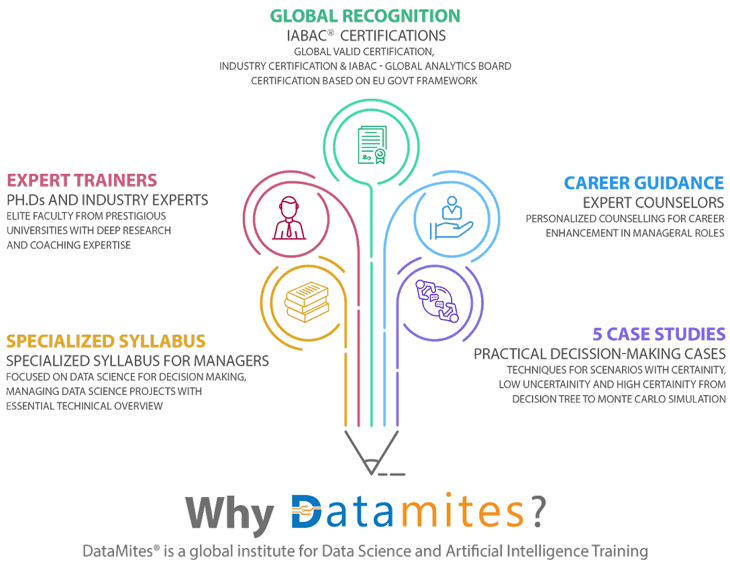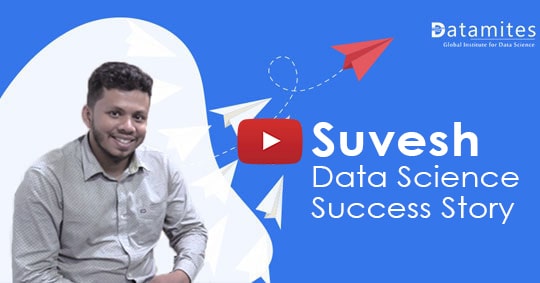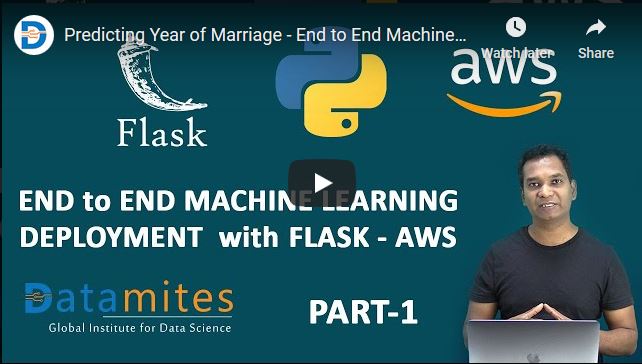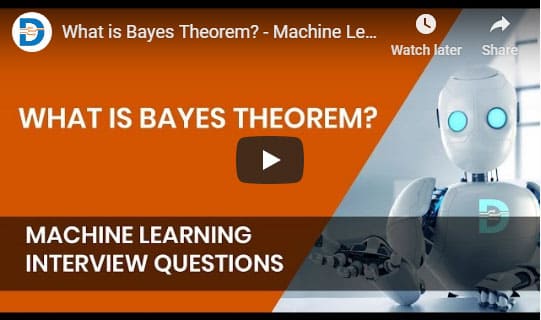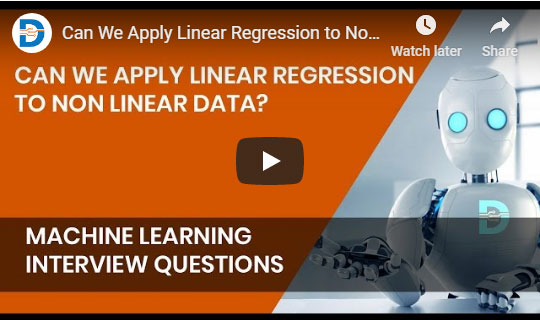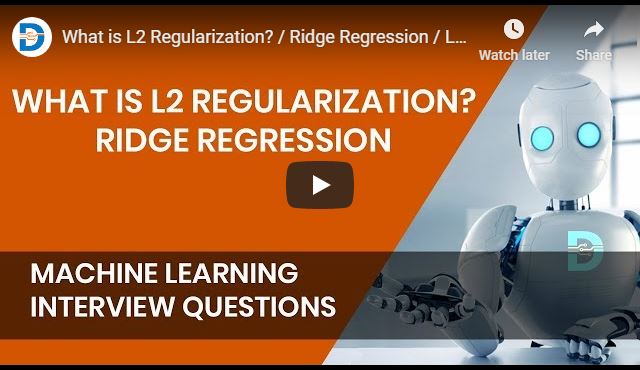Instructor Led Live Online
Self Learning + Live Mentoring
Customize Your Training
The following topics are covered here
Module 1 - Introduction to Data Science with Python
Module 2 - Python Basics: Basic Syntax, Data Structures
Module 3 - Numppy Package
Module 4 - Pandas Package
Module 5 - Python Advanced: Data Mugging with Pandas
Module 6 - Python Advanced: Visualization with MatPlotLib
Module 7 - Exploratory Data Analysis: Case Study
The following topics are covered here
Module 1: Introduction to Statistics
Module 2: Harnessing Data
Module 3: Exploratory Analysis
Module 4: Distributions
Module 5: Hypothesis & computational Techniques
Module 6: Correlation & Regression
The following topics are covered here
Module 1: Machine Learning Introduction
Module 2: Machine Learning Algorithms
Module 3: Supervised Learning
Module 4: Unsupervised Learning
The following topics are covered here
Module 1: Advanced Machine Learning Concepts
Module 2: Principle Component Analysis (PCA)
Module 3: Random Forest - Ensemble
Module 4: Support Vector Machine (SVM)
Module 5: Natural Language Processing (NLP)
Module 6: Naïve Bayes Classifier
Module 7: Artificial Neural Network (ANN)
Module 8: Tensorflow overview and Deep Learning Intro
Module 1: Tableau Introduction
Module 2: Connecting to Data Source
Module 3: Visual Analytics
Module 4: Forecasting
Module 1: Understanding Business Case
Module 2: Writing Data Science Business Case
Module 3: Benefits Analysis
Module 4: Starting project, Setting up Team and closing
Introduction to Data Science
What is Data Science?
What is Machine Learning?
What is Deep Learning?
What is Artificial Intelligence?
Data Analytics and its types
Introduction to R
What is R?
Why R?
Installing R
R environment
How to get help in R
R Studio Review
R Packages
Data Types
Variable Vectors
Lists
Environment Setup
Array
Matrix
Data Frames
Factors
Loops
Functions
Packages
In-Built Datasets
R Basics
Importing data
Manipulating data
Statistics Basics
Error metrics
Machine Learning
Supervised Learning
Unsupervised Learning
Machine Learning using R
Introduction to Deep Learning
Overview of Machine Learning Concepts
TensorFlow Essentials
ML Algorithm - Linear Regression in TensorFlow
Deep Neural Networks in TensorFlow
Convolutional Neural Networks
Reinforcement Learning in Tensorflow
Hands on Deep Learning Application with TensorFlow
Introduction to TensorFlow
Basic Statistics
Machine Learning Introduction
TensorFlow Essentials
ML Algorithm - Linear Regression in TensorFlow
ML Algorithm - Classification in TensorFlow
ML Algorithm - Clustering in TensorFlow
Simple Neural Networks in TensorFlow
Reinforcement learning
Convolutional and Recurrent Neural Networks
Case study - Stock Market Analsis with TensorFlow
About Data Science with R Course
Basic concepts of R Programming
Stack, Merge and Strsplit
Functions of R Calculator
Assigning a value to variables and generating repeat and factor levels
Performing sorting and analyze variance
Creating charts, plots, and vectors
ODBC Tables reading
Database connectivity
R language is one of the top languages that most of the companies are demanding.
Learning Data Science with R opens new career opportunities for both beginners and professionals.
It helps you achieve top programming jobs with the help of lab sessions, assignments and project work.
Also, this training program helps you prepare for the R Certification exam.
After successful completion of the course “Data Science with R”, you should have,
Gained a better knowledge of the workflow of data science with R language
Understood the key concepts of data science
Gained hands-on knowledge of R language
In-depth knowledge of data manipulation, data visualization, advanced analytics and data mining.
High demand for data scientists as a very less number of eligible candidates are available to be hired
High salaries as per the demand for data scientists as supply is low
Software Engineers and Data Analysts
SAS developers who aspire to learn the open-source technology
Business Intelligence professionals
Candidates who want to start a career in Data Science
We have 6 solid reasons to say that our DataMites is one of the best institutes for data science in Bangalore and can strongly recommend you to join with us:
IABAC accredited
Elite Faculty & Mentors
Learning Approach
10+ industry projects
24*7 Cloud Lab for ONE year
Total course fee should be paid before 50% of the course completion. We also have EMI option tied up with bank. Check with coordinators.
Certified Data Scientist is delivered in both Classroom and Online mode. Classroom is provided in selected cities in India such as Bangalore, Hyderabad.
No, Most of software are free and open source. The guidelines to setup software is a part of course.
Yes. The IABAC Exam fee is included in the course fee. No extra fee is charged.
All the online sessions are recorded and shared so you can revise the missed session. For Classroom, speak to the coordinator to join the session in another batch.
We have a dedicated PAT (Placement Assistance team) to provide 100% support in finding your dream job.
Yes, you do get job support throughout the course training. We have a special team dedicated to placement assistance, called Placement Assistance Team (PAT). We help you build your proper resume, share and skill you with top interview questions and answers in the particular technology. Also, we discuss real-world projects using specific technology that you are into.
The different payment modes that are accepted by us:
1. Online payments
2. Debit Card
3. Credit Card
As per the latest reports from Glassdoor, the average salary of a Data Science with R professional earns Rs.62,02,144/- in Bangalore. Anyhow, the salary of an individual varies based on city, industry and total years of experience.
Data Science is ruling many domains around the world. Companies are paying high wages for data science professionals. Organizations are looking out for different types of job roles in data science like:
Data Scientist
Data Analyst
Business Analytics Expert
Support Engineer
Statistical Programmer Specialist
Research Analyst
Business Analyst Consultant/ Manager
As per taking up the course, there are no such pre-requisites, but possessing certain kind of skills set would be highly beneficial:
Good critical thinking and problem-solving skills
Mathematical and Analytical skills
Technical knowledge regarding Python, R and SAS tools
Communication skills
You can attend the classes for the batch that you have registered for. And in any case, if you miss any session, you can attend the particular session with any other batch according to flexible timings.
We have a 24*7 customer support team that can help you assist with all kinds of information and queries regarding the courses. You can come forward and put your doubts to them.
Yes, you will be provided with a Data Science with R certificate from DataMites once you complete the training.
The DataMites Placement Assistance Team(PAT) facilitates the aspirants in taking all the necessary steps in starting their career in Data Science. Some of the services provided by PAT are: -
The DataMites Placement Assistance Team(PAT) conducts sessions on career mentoring for the aspirants with a view of helping them realize the purpose they have to serve when they step into the corporate world. The students are guided by industry experts about the various possibilities in the Data Science career, this will help the aspirants to draw a clear picture of the career options available. Also, they will be made knowledgeable about the various obstacles they are likely to face as a fresher in the field, and how they can tackle.
No, PAT does not promise a job, but it helps the aspirants to build the required potential needed in landing a career. The aspirants can capitalize on the acquired skills, in the long run, to a successful career in Data Science.


